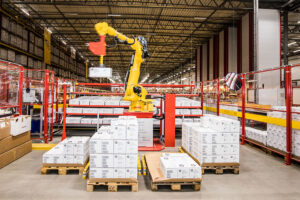
There is no doubt there will be some much needed changes to the way manufacturing is done globally as the world emerges from the COVID-19 pandemic. The disruptions in the supply chain and need for higher productivity in a safe environment will require factory managers to adopt more automation and digitization strategies.
Increased adoption of flexible automation
More and more automation has become increasingly popular across various industries. And pandemic considerations are expected to add to the justification for increased automation.
Rapidly rising labor costs in traditional offshoring countries has spurred companies to take advantage of new, more flexible industrial automation options such as cobots. These options enable manufacturing, assembly and finishing operations closer to the markets in which their end products are to be sold.
Automation could help close the growing skills gap. More companies will look to automation and robotics to help them compensate for the lack of skilled labor. They will be able to train their workers to program and maintain the robots and manage the automation instead of doing mundane tasks by hand.
Reevaluating supply chains
Supply chain disruption emerged as an early issue in the fight against COVID-19 when factories in China temporarily suspended production. In early March, the US-based National Association of Manufacturers conducted a survey that revealed one-third of participants were experiencing supply chain disruptions — costing them time and money. Factories worldwide have since had to take a hard look at and reevaluate their supply chains.
COVID-19 disruptions have caused companies to realize that their supply chain was too long; they had no Plan B to secure a minimal strategic supply capacity closer to home; and that they were left too vulnerable with little to no control of their own destiny.
One solution is to digitize supply chains. Including supply chain and partner nodes in the real-time smart operational management of the plant will allow supply chain members to respond in real time to rapidly changing market or customer demands. The plant can proactively change manufacturing priorities to react to any supply issues, missed deliveries, lack of availability, etc.
The coronavirus pandemic may be a catalyst for more companies integrating their factory automation systems to supply chain planning and execution systems.
The solution vendors have been trying to bring these different solutions together for many years and this may increase adoption. They will want to increase their overall operational resilience of their factories in response to disruptions in the demand and supply.
Working while social distancing

Social distancing may just be part of our new reality, and this will have to extend to the workplace in order to be truly effective in slowing virus transmission. Businesses of all types are having to adapt to the new normal of physical distancing, which will be harder for some industries than others.
For traditionally labor intensive industries like manufacturing, this means finding new ways to meet demand without adding to, or endangering, the current workforce. Adoption of more automation technologies will have the double benefits of increasing productivity while also keeping workers safer. However, deploying these technologies will depend on whether or not they can be integrated into the manufacturers existing technical environment and business processes.
Adapted from a&s Magazine



































































